-
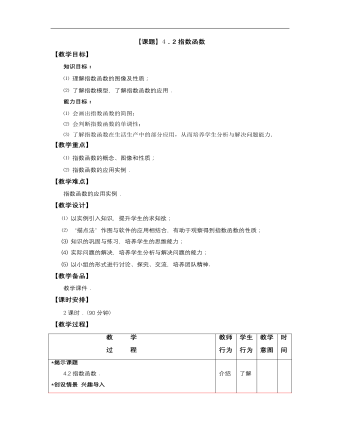
【高教版】中职数学基础模块上册:4.2《指数函数》优秀教案
【教学目标】知识目标:⑴ 理解指数函数的图像及性质;⑵ 了解指数模型,了解指数函数的应用.能力目标:⑴ 会画出指数函数的简图;⑵ 会判断指数函数的单调性;⑶了解指数函数在生活生产中的部分应用,从而培养学生分析与解决问题能力.【教学重点】⑴ 指数函数的概念、图像和性质;⑵ 指数函数的应用实例.【教学难点】指数函数的应用实例.【教学设计】⑴ 以实例引入知识,提升学生的求知欲;⑵ “描点法”作图与软件的应用相结合,有助于观察得到指数函数的性质;⑶知识的巩固与练习,培养学生的思维能力;⑷实际问题的解决,培养学生分析与解决问题的能力;⑸以小组的形式进行讨论、探究、交流,培养团队精神.【教学备品】教学课件.【课时安排】2课时.(90分钟)【教学过程】 教 学 过 程教师 行为学生 行为教学 意图时间 *揭示课题 4.2指数函数. *创设情景 兴趣导入 问题 某种物质的细胞分裂,由1个分裂成2个,2个分裂成4个,4个分裂成8个,……,知道分裂的次数,如何求得细胞的个数呢? 解决 设细胞分裂次得到的细胞个数为,则列表如下: 分裂次数x123…x…细胞个数y2=4=8=…… 由此得到, . 归纳 函数中,指数x为自变量,底2为常数. 介绍 播放 课件 质疑 引导 分析 了解 观看 课件 思考 领悟 导入 实例 比较 易于 学生 想象 归纳 领会 函数 的变 化意 义 5
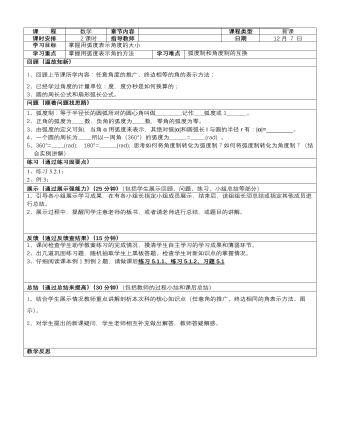
【高教版】中职数学基础模块上册:5.2《弧度制》优秀教案
课 程数学章节内容 课程类型新课课时安排2课时指导教师 日期12月 7 日学习目标掌握用弧度表示角度的大小学习重点掌握用弧度表示角的方法学习难点弧度制和角度制的互换回顾(温故知新)1、回顾上节课所学内容:任意角度的推广、终边相等的角的表示方法; 2、已经学过角度的计量单位:度,度分秒是如何换算的; 3、圆的周长公式和扇形弧长公式。问题(顺着问题找思路)1、弧度制:等于半径长的圆弧所对的圆心角叫做__________,记作____弧度或1________。 2、正角的弧度为_____数,负角的弧度为_____数,零角的弧度为零。 3、由弧度的定义可知,当角α用弧度来表示,其绝对值|α|和圆弧长l与圆的半径r有:|α|=________。 4、一个圆的周长为_____,所以一周角(360°)的弧度为_______=______(rad) 。 5、360°=_____(rad); 180°=_______(rad); 思考如何将角度制转化为弧度制?如何将弧度制转化为角度制?(结合实例讲解)练习(通过练习固要点)1、练习5.2.1; 2、例3;展示(通过展示强能力)(25分钟)(包括学生展示回顾、问题、练习、小组总结等部分)1、引导各小组展示学习成果,在有各小组长指定小组成员展示,结束后,该组组长须总结或指定其他成员进行总结。 2、展示过程中,提醒同学注意老师的板书,或者请老师进行总结,或题目的讲解。
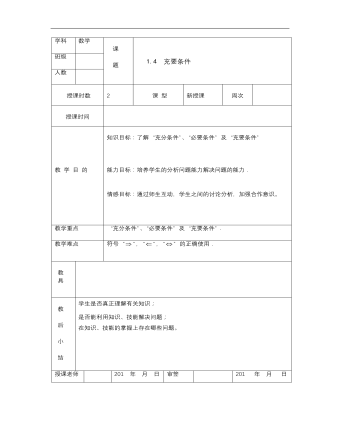
【高教版】中职数学基础模块上册:1.4《充要条件》优秀教案
学科数学 课 题 1.4 充要条件班级 人数 授课时数 2 课 型 新授课 周次 授课时间 教 学 目 的 知识目标:了解“充分条件”、“必要条件”及“充要条件” 能力目标:培养学生的分析问题能力解决问题的能力. 情感目标:通过师生互动,学生之间的讨论分析,加强合作意识。 教学重点“充分条件”、“必要条件”及“充要条件”.教学难点符号“”,“”,“”的正确使用. 教 具 教 后 小 结 学生是否真正理解有关知识; 是否能利用知识、技能解决问题; 在知识、技能的掌握上存在哪些问题。
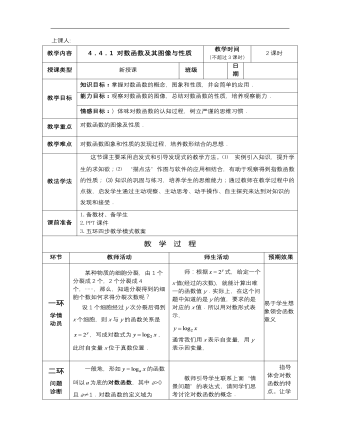
【高教版】中职数学基础模块上册:4.4《对数函数》优秀教案
教学内容4.4.1 对数函数及其图像与性质教学时间 (不超过3课时)2课时授课类型新授课班级 日期 教学目标知识目标:掌握对数函数的概念,图象和性质,并会简单的应用.能力目标:观察对数函数的图像,总结对数函数的性质,培养观察能力.情感目标:)体味对数函数的认知过程,树立严谨的思维习惯.教学重点对数函数的图像及性质.教学难点对数函数图象和性质的发现过程,培养数形结合的思想.教法学法这节课主要采用启发式和引导发现式的教学方法。⑴ 实例引入知识,提升学生的求知欲;⑵ “描点法”作图与软件的应用相结合,有助于观察得到指数函数的性质; ⑶知识的巩固与练习,培养学生的思维能力;通过教师在教学过程中的点拨,启发学生通过主动观察、主动思考、动手操作、自主探究来达到对知识的发现和接受.课前准备1.备教材、备学生 2.PPT课件 3.五环四步教学模式教案教 学 过 程环节教师活动师生活动预期效果一环 学情 动员某种物质的细胞分裂,由1个分裂成2个,2个分裂成4个,……,那么,知道分裂得到的细胞个数如何求得分裂次数呢? 设1个细胞经过y次分裂后得到x个细胞,则x与y的函数关系是,写成对数式为,此时自变量x位于真数位置.师:根据式,给定一个x值(经过的次数),就能计算出唯一的函数值y.实际上,在这个问题中知道的是y的值,要求的是对应的x值.所以用对数形式表示, 通常我们用x表示自变量,用y表示因变量, 易于学生想象领会函数意义二环问题 诊断一般地,形如的函数叫以为底的对数函数,其中a>0且a≠1.对数函数的定义域为,值域为R. 例如、、都是对数函数. 教师引导学生联系上面“情景问题”的表达式,请同学们思考讨论对数函数的概念. 师:(1) 为什么规定 a>0且 a≠1? (2) 为什么对数函数的定义域是(0,+∞)? 指导体会对数函数的特点。让学生牢记底数大于零且不等于1,真数大于零.
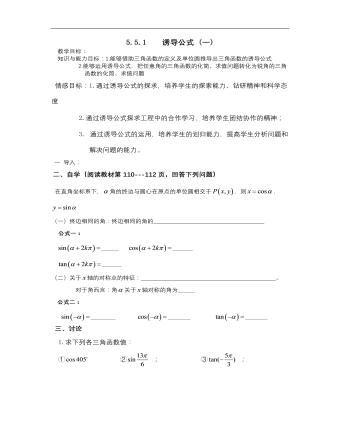
【高教版】中职数学基础模块上册:5.5《诱导公式》优秀教案
教学目标:知识与能力目标:1.能够借助三角函数的定义及单位圆推导出三角函数的诱导公式 2.能够运用诱导公式,把任意角的三角函数的化简、求值问题转化为锐角的三角函数的化简、求值问题情感目标:1.通过诱导公式的探求,培养学生的探索能力、钻研精神和科学态度 2.通过诱导公式探求工程中的合作学习,培养学生团结协作的精神; 3. 通过诱导公式的运用,培养学生的划归能力,提高学生分析问题和解决问题的能力。 一导入:二、自学(阅读教材第110---112页,回答下列问题) 在直角坐标系下,角的终边与圆心在原点的单位圆相交于,则,(一)终边相同的角:终边相同的角的 公式一:_______ ________________(二)关于轴的对称点的特征: 。对于角而言:角关于轴对称的角为_______公式二:__________ _________ _________
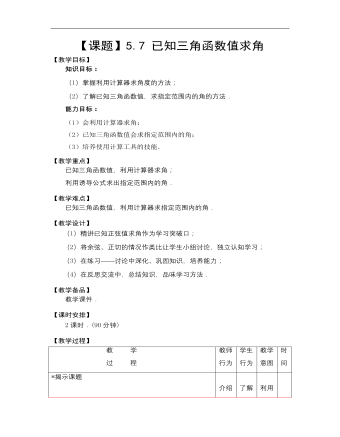
【高教版】中职数学基础模块上册:5.7《已知三角函数值求角》优秀教案
【教学目标】知识目标:(1)掌握利用计算器求角度的方法;(2)了解已知三角函数值,求指定范围内的角的方法.能力目标:(1)会利用计算器求角;(2)已知三角函数值会求指定范围内的角;(3)培养使用计算工具的技能.【教学重点】已知三角函数值,利用计算器求角;利用诱导公式求出指定范围内的角.【教学难点】已知三角函数值,利用计算器求指定范围内的角.【教学设计】(1)精讲已知正弦值求角作为学习突破口;(2)将余弦、正切的情况作类比让学生小组讨论,独立认知学习;(3)在练习——讨论中深化、巩固知识,培养能力;(4)在反思交流中,总结知识,品味学习方法.【教学备品】教学课件.【课时安排】2课时.(90分钟)【教学过程】 教 学 过 程教师 行为学生 行为教学 意图时间 *揭示课题 5.7已知三角函数值求角 *构建问题探寻解决 问题 已知一个角,利用计算器可以求出它的三角函数值, 利用计算器,求= (精确到0.0001): 反过来,已知一个角的三角函数值,如何求出相应的角? 解决 准备计算器.观察计算器上的按键并阅读相关的使用说明书.小组内总结学习已知三角函数值,利用计算器求出相应的角的方法. 利用计算器求出x:,则x= 归纳 计算器的标准设定中,已知正弦函数值,只能显示出?90°~ 90°(或)之间的角. 介绍 质疑 提问 引导 说明 了解 思考 动手 操作 探究 利用 问题 引起 学生 的好 奇心 并激 发其 独立 寻求 计算 器操 作的 欲望 10
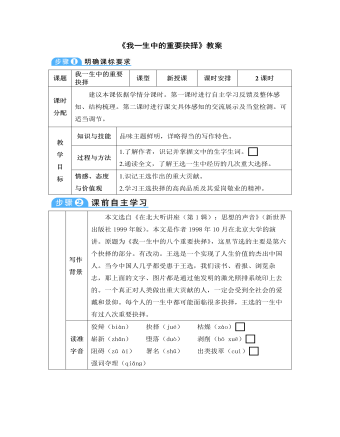
部编版语文八年级下册《我一生中的重要抉择》教案
(1)一个快落山的太阳,跟大家讲的,更多的是自己一生奋斗过来的体会。指61岁的老人。(2)加入人家说我是权威,也许还马马虎虎。作者自谦的说法,指成绩还过得去。(3)明明是一个过去时态,大家误认为是现在时态。指作者认为自己不适合再做权威了。(4)扶植年轻人我觉得是一种历史的潮流,当然我们要创造条件,就是把他们推到需要刺激的风口浪尖上。比喻重要的岗位或市场的前沿。【感悟精彩句子】1.所以我知道自己是一个下午四五点钟的太阳。各位呢,上午八九点钟的太阳,这是本科生;硕士生呢,九十点钟的太阳;博士生呢,十点十一点钟的太阳。比喻,拉近了与听众的距离,倍感亲切、期望和鼓舞。2.所以1992年前电视台采访我,我基本上都拒绝了。透过细节,体现了坚持不懈的科研精神。
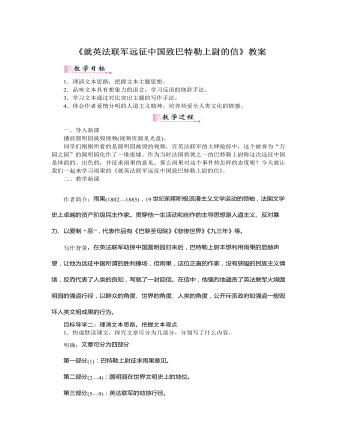
部编版语文九年级上册《就英法联军远征中国致巴特勒上尉的信》教案
3.作者是如何表达出自己的观点的?明确:作者首先以瑰丽的语言盛赞圆明园在人类文明中的地位,其后,又以比喻及反讽的修辞,将英法联军劫掠圆明园的罪行揭露而出,两者形成鲜明的对比,从而引出谴责英法联军远征中国行为的观点。目标导学三:了解作者心中的圆明园及英法联军的强盗行径1.作者是如何描述他心目中的圆明园的?明确:圆明园是幻想的某种规模巨大的典范,一座言语无法形容的建筑,某种恍若月宫的建筑。作者用大理石,玉石,青铜,瓷器,雪松,宝石,绸缎,神殿,后宫,城楼,神像,异兽,琉璃,珐琅,黄金,脂粉,一座座花园,一方方水池,一眼眼喷泉,成群的天鹅、朱鹭和孔雀等无数华贵的象征,铺就了一张华贵的想象画面,构成他心中的圆明园。正如他所说“总而言之,请你假设人类幻想的某种令人眼花缭乱的洞府,其外观是神庙,是宫殿,那就是这座园林”。
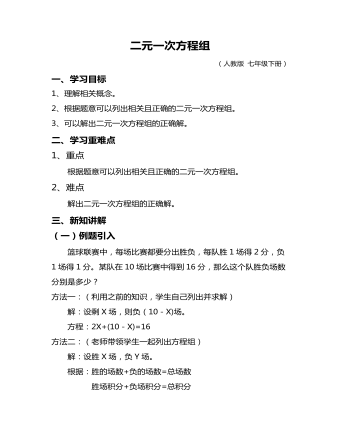
初中数学人教版二元一次方程组教学设计教案
(一)例题引入篮球联赛中,每场比赛都要分出胜负,每队胜1场得2分,负1场得1分。某队在10场比赛中得到16分,那么这个队胜负场数分别是多少?方法一:(利用之前的知识,学生自己列出并求解)解:设剩X场,则负(10-X)场。方程:2X+(10-X)=16方法二:(老师带领学生一起列出方程组)解:设胜X场,负Y场。根据:胜的场数+负的场数=总场数 胜场积分+负场积分=总积分得到:X+Y=10 2X+Y=16
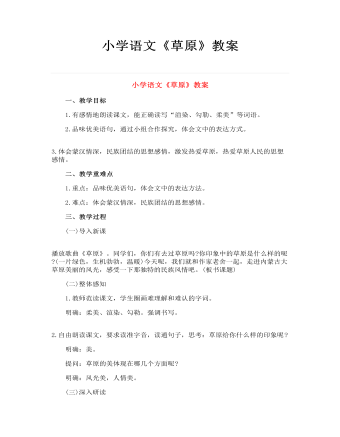
小学语文《草原》教案
二、教学重难点 1.重点:品味优美语句,体会文中的表达方法。 2.难点:体会蒙汉情深,民族团结的思想感情。 三、教学过程 (一)导入新课 播放歌曲《草原》。同学们,你们有去过草原吗?你印象中的草原是什么样的呢?(一片绿色,生机勃勃,温暖)今天呢,我们就和作家老舍一起,走进内蒙古大草原美丽的风光,感受一下那独特的民族风情吧。(板书课题)
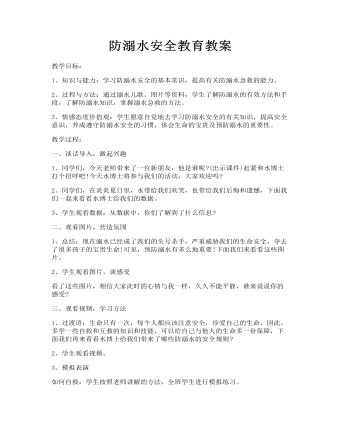
防溺水安全教育教案
一、谈话导入,激起兴趣1、同学们,今天老师带来了一位新朋友,他是谁呢?(出示课件)赶紧和水博士打个招呼吧!今天水博士将参与我们的活动,大家欢迎吗?2、同学们,在炎炎夏日里,水带给我们欢笑,也带给我们后悔和遗憾,下面我们一起来看看水博士给我们的数据。3、学生观看数据:从数据中,你们了解到了什么信息?
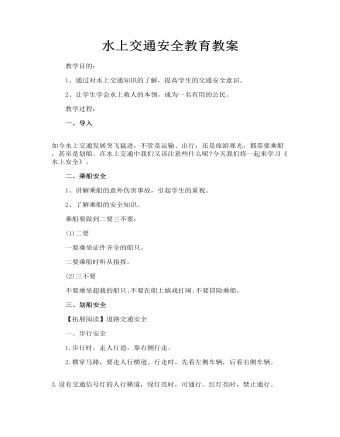
水上交通安全教育教案
二、乘船安全 1、讲解乘船的意外伤害事故,引起学生的重视。 2、了解乘船的安全知识。 乘船要做到二要三不要: (1)二要 一要乘坐证件齐全的船只。 二要乘船时听从指挥。 (2)三不要 不要乘坐超载的船只;不要在船上嬉戏打闹;不要冒险乘船。
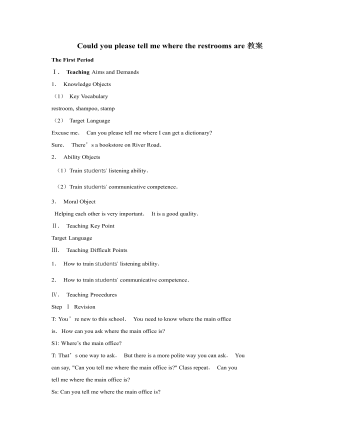
人教版新目标初中英语九年级下册Could you please tell me where the restrooms are教案
Step Ⅰ RevisionCheck homework. Ask a few students to read the article in 3a.Then ask a few students to read their guides.Step Ⅱ Part 1Look at the words in the box. Ask a student to read them. Make sure the students understand the meaning of the words. You are to fill in the blanks with the words. In some cases, students may need to use another form of the word, for example adjusting for tense or subject/ verb agreement.Ask students to fill in the blanks on their own.Check the answers. Step ⅢPart 2Go through the instructions with the class.Look at the example with the students.Ask students what the answer would be.Ask a student to read the question and answer it.Excuse me, could you tell me where the bank is, please?The bank is across the street from the shopping malt.Get students to complete the work in pairs.Check the answers. Ask a few students to read their questions.Step Ⅳ Just for Fun!Ask all the students to read the conversation. Ask: What is funny about this cartoon? Help students to explain. A Martian is a person from the planet Mars.There is no such thing as Martian food on Earth, and the clerk looks silly because he is trying to think of where there is a Martian restaurant.Invite some pairs of students to present this conversation to the rest of the class.Step Ⅴ Summary and HomeworkIn this class, we’ve done much writing practice using the key vocabulary words and the target language presented in this unit. After class, please finish the questions in 2 in your exercise books. Then finish the exercises on pages 47~48 of the workbook as well.The Seventh Period Ⅰ Teaching Aims and Demands1. Knowledge Objects(1) Key Vocabularyimage, adventure, jealousy, hero, crime, journey, brave, no longer, show interest in, take it easy, become interested in, plain looks(2)Text:Grown-ups like cartoons, too.2. Ability Objects(1) Fast-reading to get a general idea of the text.(2) Careful-reading to get the detailed information in the text.
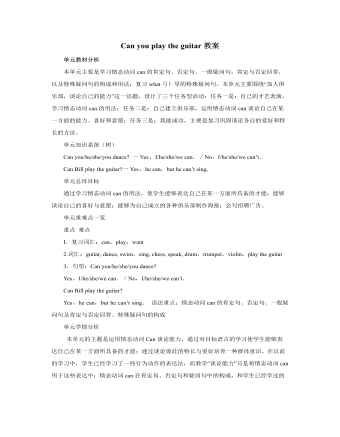
人教版新目标初中英语七年级上册Can you play the guitar教案
本单元主要是学习情态动词can的肯定句、否定句、一般疑问句,肯定与否定回答,以及特殊疑问句的构成和用法;复习what弓!导的特殊疑问句。本单元主要围绕“加人俱乐部,谈论自己的能力”这一话题,设计了三个任务型活动:任务一是:自己的才艺表演,学习情态动词can的用法;任务二是:自己建立俱乐部,运用情态动词can谈论自己在某一方面的能力、喜好和意愿;任务三是:我能成功,主要是复习巩固谈论各自的爱好和特长的方法。单元知识系统(树)Can you/he/she/you dance? 一Yes,I/he/she/we can./No,I/he/she/we can’t.Can Bill play the guitar?一Yes,he can,but he can’t sing.单元总体目标通过学习情态动词can的用法,使学生能够表达自己在某一方面所具备的才能;能够谈论自己的喜好与意愿;能够为自己成立的各种俱乐部制作海报;会写招聘广告。单元重难点一览重点 难点I.复习词汇:can,play,want2.词汇:guitar, dance, swim,sing, chess, speak, drum,trumpet,violin,play the guitar3.句型:Can you/he/she/you dance?Yes,I/he/she/we can./No,I/he/she/we can’t.Can Bill play the guitar?

人教版新目标初中英语七年级上册Do you want to go to a movie教案
讨论喜欢的影视类型及理由:在看过一部影视作品后,大家总是喜欢在一起谈论影视的主要内容、主要情节、主要演员主题歌曲、主题音乐等,互相介绍自己对该影视的看法。教师可以组织一次活动,分组讨论学生喜欢看什么类型的电影,并说明喜欢的理由。运用I like…I don’t like…Because it is…等语言结构;然后每个组选派一名代表向全班学生阐述本组组员喜欢观看的电影类型;最后汇总,总结出全班同学最喜欢观看哪一种类型的电影。如果有可能,根据学生的选择放一部(一段)这种类型的影视节目。通过学生的讨论、调查,使他们在完成任务的过程中学会询问和陈述自己或别人在影视方面的喜好及理由,更好地巩固所学内容。Self Check教学内容Self Check(教材P58)教学目标知识与能力复习词汇go,movie,action,comedy,documentary,thriller,and,but,scary,funny, sad,exciting;引导学生复习、巩固“制订计划和打算并谈论喜好和偏爱”的目标语言。

人教版新目标初中英语七年级上册How much are these pants教案
个性练习设计 阅读广告:在日常生活中,人们去买东西之前,一般要阅读广告,从广告中获取该商品的一些有用信息,包括价格、性能等。所以给学生提供有些商品的广告或让学生去商店去阅读一些商品的广告,从中获取商品的价格,即可以锻炼学生的阅读能力,又能提高实践能力。 Self Check 教学内容 Self Check(教材P42) 教学目标 知识与能力 复习词汇pant,sock,T-shirt,sweater,shoes,color,black,white,red,green,blue,big,short,long,数字10--31; 学习词汇Zig Zag,clothes,shop,yellow,ask,which;学会谈论服装的价格、颜色、大小和长短;学会填写价格标签。 过程与方法 运用Summarizing和Classifying的学习策略。在复习教学中,运用听写、绘画、互相询问调查与检测等手段,促使学生不断地使用所学内容,从而提高他们灵活运用知识的能力。 情感态度价值观 该部分学习内容主要是复习谈论服装的价格和颜色以及对服装的喜好,能引起学生的共鸣;通过购物的对话练习教学生学会购物时使用的礼貌用语和如何感谢人。

人教版新目标初中英语七年级上册What time do you go to school教案
知识与能力复习词汇time,morning,breakfast,get up,g0 t0 bed,homework,clock,afternoon,lunch,run,watch TV,evening,dinner,eat,usually,o’clock,thirty,fifteen,take a shower,go t0 school等;引导学生复习、巩固“询问和谈论时间”的目标语言并运用所学知识安排自己的学习和课外活动。过程与方法运用Summarizing,Classifying和Comparing的学习策略。在复习教学中,运用听写、提问、对话演练与调查活动,促使学生不断地使用所学内容,从而提高他们灵活运用知识的能力。情感态度价值观本部分的主要内容是复习“日常作息时间”的询问和表达。通过互相询问或谈论自己或对方的作息时间安排和活动计划,培养学生良好的作息习惯和守时习惯。教学重、难点及教学突破重点复习词汇time,morning,breakfast,get up,g0 to bed,homework,clock,afternoon,lunch,run,watch TV,evening,dinner,eat,usually,o’clock,thirty,fifteen,take a shower,go to school等;引导学生复习、巩固“询问和谈论时间”的目标语言。
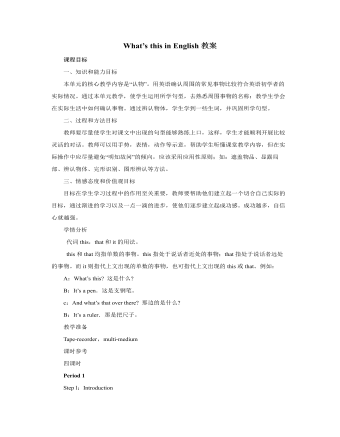
人教版新目标初中英语七年级上册What’s this in English教案
一、知识和能力目标本单元的核心教学内容是“认物”。用英语确认周围的常见事物比较符合英语初学者的实际情况。通过本单元教学,使学生运用所学句型,去熟悉周围事物的名称;教学生学会在实际生活中如何确认事物。通过辨认物体,学生学到一些生词,并巩固所学句型。二、过程和方法目标教师要尽量使学生对课文中出现的句型能够熟练上口,这样,学生才能顺利开展比较灵活的对话。教师可以用手势,表情,动作等示意,帮助学生听懂课堂教学内容,但在实际操作中应尽量避免“明知故问”的倾向,应该采用应用性原则;如:遮盖物品、显露局部、辨认物体、完形识别、图形辨认等方法。三、情感态度和价值观目标目标在学生学习过程中的作用至关重要,教师要帮助他们建立起一个切合自己实际的目标,通过渐进的学习以及一点一滴的进步,使他们逐步建立起成功感。成功越多,自信心就越强。
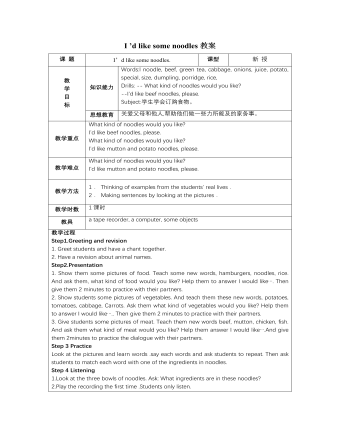
人教版新目标初中英语七年级下册I ’d like some noodles教案
教学过程Step 1: warming-up Sing a song---------“food and drink” Step 2: Revision1 Dictation2 Revise: What kind of noodles would you like?I’d like …What size bowl of noodles would you like?I’d like…Step 3: Presentation1 show pictures of food, ask students say the words.2 Students read the newspaper ad in 3a. Fill in blanks with words in the box. Then read the ad together, the teacher explains some difficult language points.3 Check the answers Step 4 PracticeAsk students to finish 3b in the same way according to 3a. Students read the short passage and fill in the blanks .At last, check the answers.Step 5 productionAsk students to write their own ad for dumplings, noodles, drinks, and other foods they know. Then ask students to read their partner’s ad. Then order food and drink from their partner.Step 6 Home workGroup work – make an ad about “food and drink”

人教版新目标初中英语七年级下册Where is your pen pal from教案
2.1Match the country with the language.Step II Reading3a? let the students read the letter fast and answer the questions.? Let the students ask more questions about the letter as possible as the can.Step III Writing3b.Step IV. Pairwork2cStep V Listening2a, 2bStep V. HomeworkExercises book(1) P3Exercises book (2) P3Period FourStep I . Dictate the words and sentences in Unit1.Step II. Self-checkStep III. Check the answers for Exercises book in the unit.Step IV. Home workRevise and preparation for unit 2.教学反思:通过本单元的学习,学生基本可以谈论人们的国籍,居住城市及其所说的语言,通过书信方式去介绍自己并寻找笔友。但在涉及到国外的一些城市时,学生对这方面的知识相对欠缺,能介绍的城市并不多,也反应出学生课前预习不充分,这跟学生学习条件也有关,大多数学生无法通过网络获取所需信息。因此,在以后的教学中要多指导学生通过计算机网络获取信息,拓宽知识面。

